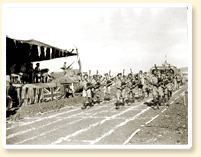

The pipers of the 48th Highlanders of Canada, an infantry unit from Toronto, Ont.,
entertain at a Canadian Army track and field meet during a rest period in the battle for Sicily, 23
August 1943.
Canadian Military Photograph
|
The Canadian Armed Forces: The Canadian Army
The pre-Second World War Canadian 'Militia,' was tiny and its
resources few: it had, for example, only ten Bren light machine
guns for the entire . By 1945, there were 730,159 men and women
in the , an astounding number for a country of only 12 million
people who were far away from the main action. After the declaration of war, the government announced that it
would raise two army divisions, one for service overseas and one
for home defence. By 1943 the overseas force, based in Britain,
had grown into the First Canadian , with three infantry and
two armoured divisions, as well as two armoured and support
troops. The equivalent of three more were serving on home
defence duties in Canada. The began sustained combat when the 1st Canadian Infantry joined in the Allied invasion of Sicily in July 1943 ( see
the Sicilian and Italian campaigns ). From then on the played
a significant part in the defeat of the Italy and Germany, especially
after ,
6 June 1944, when the 3rd Canadian Infantry landed in Normandy, followed into action by the main body of the
First Canadian ( see D-Day and the Normandy Campaign ). The whole of fought continuously until the
end in Northwest Europe. To this day,
the people of Holland remember the Canadian liberation of
their country. Related Newspaper Articles
English Articles
French Articles
-
"La première division canadienne d'outre-mer, comprenant 16,000 hommes est maintenant en Angleterre"
Le Devoir, 02/01/1940
-
Un corps expéditionnaire canadien plus nombreux?
Le Devoir, 05/01/1940
-
Le gouvernement canadien décide la création d'une quatrième division
Le Devoir, 06/05/1940
-
Bloc-Notes - Le général Tremblay
Le Devoir, 23/05/1940
-
Notre Milice devient l'armée canadienne
Le Devoir, 08/01/1941
-
Nos camps d'entrainement
Le Devoir, 28/02/1941
-
Chez le général Panet. Les meilleurs soldats sont les volontaires
Le Devoir, 25/06/1941
-
Création d'une sixième division canadienne
Le Devoir, 08/08/1941
-
"Une brigade canadienne aux points stratégiques en Angleterre"
Le Devoir, 07/01/1942
-
Réorganisation importante et considérable parmi nos officiers outre-mer. On a besoin de sang plus jeune
Le Devoir, 12/01/1942
-
La Femme dans l'armée. L'enrôlement dans la C.A.F.A.C.
Le Devoir, 31/01/1942
-
Le général McNaughton demande des technicien
Le Devoir, 05/02/1942
-
Quartier généraux de la première armée canadienne établis en Angleterre
Le Devoir, 06/04/1942
-
Grande responsabilités des unités de réserve
Le Devoir, 20/05/1942
-
Des mécaniciens pour notre armée
Le Devoir, 23/07/1942
-
Les premiers parachutistes canadiens
Le Devoir, 28/07/1942
-
Une nouvelle unité de spécialistes canadiens et américains de la guerre offensive
Le Devoir, 06/08/1942
-
L'armée canadienne en Angleterre
Le Devoir, 02/09/1942
-
Bloc-notes. Deux divisions dans le pacifique. Un corps d'armée
Le Devoir, 11/05/1945
-
L'armée canadienne d'occupation
Le Devoir, 28/05/1945
|